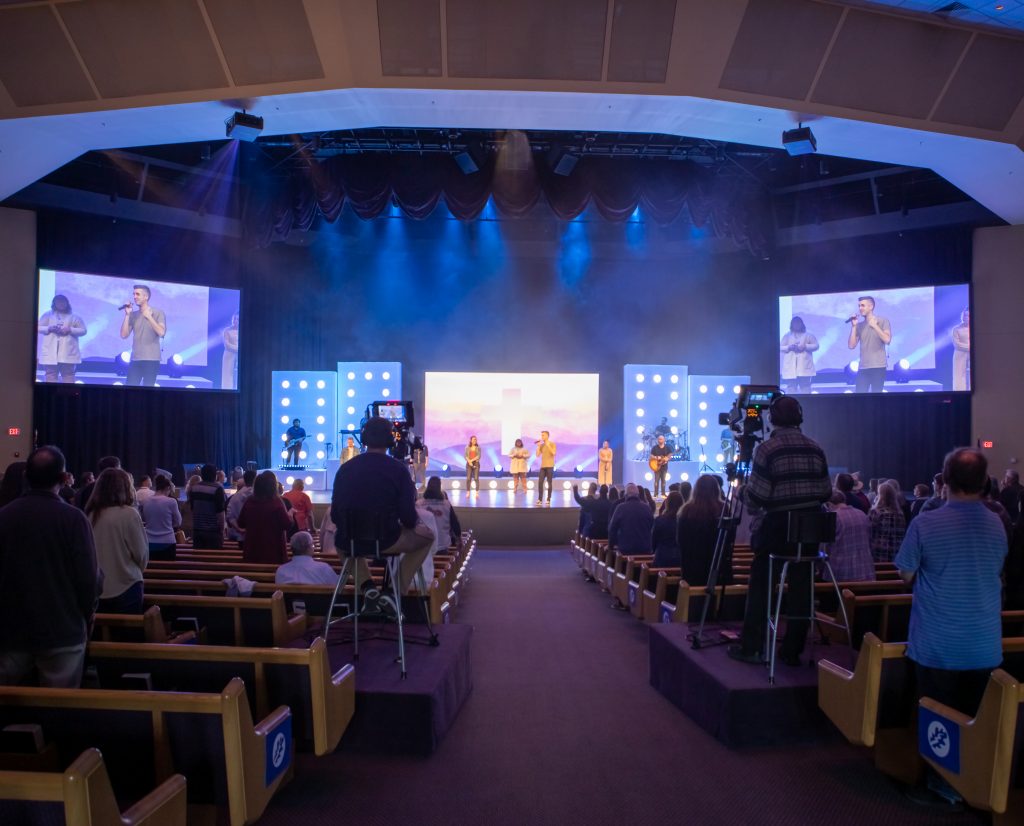from our September 2023 issue

by Steve Milley
Even as in-person worship attendance rises, 9 out of 10 churches are still offering hybrid services and 81% plan to continue doing so in the future. This means these churches will need the right technology to deliver an engaging in-person and remote worship experience.
Yet, for many churches, deploying new solutions is daunting, especially for ones that rely on teams of volunteers to manage their production tech. In fact, 86% of church leaders report that they don’t want extra technology. Rather, they want cohesive solutions that empower them to solve real problems.
Implementing a comprehensive ecosystem of AV solutions helps houses of worship create engaging services that expand their at-home viewership and in-person attendance. Let’s look at some of the top solutions to consider when designing this ecosystem.
Inspire In-person Worshippers with Vibrant Imagery via Projection Technology
Listening has always been a critical component of a worship service. Worshippers listen to announcements, to sermons, to music. However, not everyone can fully process information auditorily, especially in our visual society where 90% of information transmitted to the brain is visual.
With the right projection technology, worship leaders can project a reading so all attendees can follow along together. They can also present visuals to help people better understand the meaning behind a passage or sermon. Beyond that, this level of vivid imagery can spark emotion, creating a shared audience experience.
House of Worship venues should seek out small and compact projectors to avoid taking up too much space. High brightness and exceptional image quality are also critical, so audiences see a clear image regardless of where they are seated or whether the worship leader dims the lights or lets the sun stream in.
Grow Your Community with Enhanced Information Sharing via Professional Displays
Churches are currently seeing only 85% of their January 2020 attendance numbers. Attracting new congregants is the first step to increasing attendance. The next step is retaining worshippers by building a strong sense of community.
Establishing a close-knit community starts with offering a seamless, inclusive worship experience. Imagine walking into a new worship setting and not knowing where to sit or how to find the page numbers to follow along with the readings and songs. With professional displays, worship leaders can easily and clearly share the page numbers for the reading to make sure everyone can follow along.
Likewise, during a busy worship service, digital signage can share wayfinding information to guide people to extra seating. And on busy holidays when it’s impossible to fit all worshippers in one room, worship leaders can use displays to stream their service to audiences in a neighboring room. This way, all congregants receive the same message instead of hosting two simultaneous services.
Digital signage can also share important information about community gatherings whether it’s the logistics for a clothing drive or the time and location of an upcoming church picnic. Ensuring that everyone has access to this information in a way that’s clear and easy to read is essential to building a strong worship community that inspires congregants to keep returning.
Professional displays that offer high brightness and a wide viewing panel support the best viewing experience. An anti-glare panel and minimum haze treatment will also reduce the reflection of ambient light and enhance visibility. Similarly, ease of installation and scalability make it easy to add more displays when the need arises.
Help Remote Worshippers Feel Connected with High-Quality Cameras
When worshipping remotely, it can be challenging for people to feel a strong sense of community. For starters, more than half of U.S. adults who regularly watch religious services online or on TV say they watch by themselves. Beyond that, only 28% of virtual worshippers feel “a great deal” or “quite a bit” of connection with the people who physically attend the services they watch and only 22% feel strongly connected to other people tuning in remotely.
High quality cameras are critical to create an authentic remote worship experience that makes at home worshippers feel connected. Given their compact size, PTZ cameras can easily be placed around beams and pillars within the space so as not to interfere with the design and aesthetic of a sanctuary, which can often be quite ornate, especially in older churches. This ensures the in-person experience is uninterrupted visually. Panning the room and zooming into different scenes, PTZ cameras offer a panoramic view of the space to make at-home worshippers feel as if they are present in person.
While PTZ cameras help worship leaders subtly stream an in-person service, houses of worship that look to create their own remote service should look to studio cameras for high production quality. These cameras can capture a clear, crisp image in any lighting environment, so worship leaders can dim the lights during moments of quiet prayer and contemplation and turn them up when they are ready to speak. Studio cameras that support multi-camera productions offer greater flexibility to capture more dynamic content.
Support a Seamless Viewing Experience with the Right Production Switcher & Audio Technology
Six-in-ten Americans who tune into worship services remotely say their primary reason for doing so is to watch services held far away from where they live. This means streamed worship services face greater competition than their in-person counterparts, where worshippers are limited by geography. With so many options available to remote worshippers, the production quality of the streamed service becomes critical.
Deploying multiple cameras to capture footage helps create a dynamic worship experience. However, it can be challenging to compile all video and content feeds together into one cohesive stream, especially for volunteer production teams who may not have extensive experience producing a remote service.
The right switcher technology can help streamline these workflows. It’s important to look for a solution that is software-based for the flexibility to combine multiple video and graphical sources and move beyond the constraints of a traditional hardware-based system.
Not only can this type of video production platform simplify streaming workflows, it can also control the visuals shared via projection and display technology to streamline production for both in-person and remote services.
Another key feature that has a significant impact on audience experience for both remote and in-person worshippers is audio. Imagine the frustration of attending a service in person and not being able to clearly hear the speaker. And if the audio is poor for a livestream, viewers will simply watch a service from another house of worship. That’s where it becomes critical for houses of worship to deploy a wireless microphone system that delivers secured, high-quality sound in both small and large spaces. Having a microphone and receiver that are pair-registered prevents interference from other wireless devices. And easy set-up ensures a seamless experience for volunteer production teams.
Producing a Service Fit for All
A connected ecosystem of AV technology inclusive of projector, display, audio, video, and production technologies helps any house of worship enhance their hybrid services. Deploying the right solutions within this ecosystem empowers worship leaders to engage congregants and build a strong community of returning worshippers.
Steve Milley is the Director of Sales, Professional Imaging & Visual Systems at Panasonic Connect




